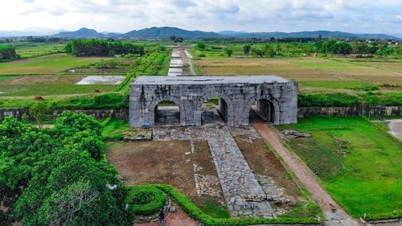THU SUONG
In daily life, the body can experience significant conditions, such as atherosclerosis, plaque buildup in the arteries causing blockages or weakening of the artery walls, leading to the formation of aneurysms. The most dangerous is an abdominal aortic aneurysm; when it ruptures, the patient faces a very high risk of death, yet they are often unaware of their condition unless screened. Recently, doctors at Can Tho City General Hospital have successfully saved many patients with life-threatening abdominal aortic aneurysms.
Dr. Truong Dinh Hung examines a patient after surgery. Photo provided by the hospital.
Ms. TTB (71 years old, residing in Vinh Thanh District, Can Tho City) has just been discharged from the hospital after a life-threatening condition due to a ruptured abdominal aortic aneurysm. On June 8, 2023, she visited Can Tho City General Hospital for examination due to dull abdominal pain in the epigastric and periumbilical regions. She also suffered from hypertension and dyslipidemia. After examination and results from abdominal ultrasound and CT scan, doctors diagnosed her with an infrarenal abdominal aortic aneurysm measuring 45mm in diameter and 7cm in length, with ulceration of the vessel wall. Doctors consulted and decided to perform surgery to replace the aneurysmal segment with an artificial vascular graft. The surgery was successful, and the patient was discharged in stable condition.
In mid-May 2023, a 62-year-old male patient from Thoi Lai district was admitted to Can Tho City General Hospital with persistent abdominal pain around the navel that did not subside with painkillers. After examination, abdominal ultrasound, and CT scan, doctors discovered a large infrarenal abdominal aortic aneurysm with a maximum diameter of 50mm and a length of approximately 19cm. For this patient, the doctors consulted and decided to perform surgery to replace the aneurysm with an artificial vascular graft. During the surgery, the surgeons observed an old blood clot adhering to the wall and an infected plaque inside the aneurysm sac. The surgery was successful, and the patient recovered well and was discharged from the hospital.
According to Dr. Truong Dinh Hung, Specialist in Thoracic and Vascular Surgery at Can Tho City General Hospital, the abdominal aorta supplies blood to the organs in the abdominal cavity and the lower half of the body. An abdominal aortic aneurysm increases the diameter by at least 50% compared to normal. In Vietnamese people, an abdominal aorta with a diameter of 30-35mm or more is considered an aortic aneurysm. It is estimated that approximately 200,000 people worldwide die each year from ruptured infrarenal aortic aneurysms.
Abdominal aortic aneurysms are caused by many factors, with atherosclerosis accounting for over 95% of cases. Other, less common causes include congenital defects, genetic factors, infections, trauma, and post-surgical complications. People over 60 years old are at a higher risk of developing abdominal aortic aneurysms. Men are four times more likely to develop abdominal aortic aneurysms than women. The condition also has a genetic component, with approximately 20-29% of relatives of patients with abdominal aortic aneurysms being found to have the condition. Furthermore, lifestyle factors such as smoking, hypertension, and metabolic disorders of glucose and lipids also increase the risk.
According to specialists, most abdominal aortic aneurysms are asymptomatic. The most dangerous complication is rupture of the abdominal aortic aneurysm. If it ruptures in the abdomen, the patient immediately experiences abdominal pain, back pain, hypotension, and tachycardia. Most patients die before reaching a medical facility. Even those who survive until they reach the hospital have a very high mortality rate. Another complication is distal embolism due to a thrombus or atherosclerotic plaque breaking off and obstructing the renal, intestinal, and lower extremity arteries.
Most abdominal aortic aneurysms are diagnosed incidentally during clinical examination or abdominal ultrasound. Other diagnostic methods include computed tomography (CT) scans or MRI. In treatment, medical monitoring is applied to cases with small, fusiform aneurysms (less than 4 cm), severe comorbidities, surgical difficulties, or patient refusal of surgery. Most patients with large aneurysms at risk of rupture will undergo surgery to replace the aortic aneurysm with a vascular graft. Additionally, endovascular intervention may be used to treat this condition, but the cost is very high.
Over the past period, the Thoracic and Vascular Surgery Department of Can Tho City General Hospital has successfully received, treated, and surgically treated many cases of infrarenal abdominal aortic aneurysms. Many cases involved large aneurysms or those at risk of rupture, or those that had already ruptured. Doctors primarily replaced the aneurysmal segment with an artificial vascular graft, achieving high treatment efficacy and rapid recovery. Dr. Pham Van Phuong, Deputy Director of the hospital, said that in the future, the hospital will continue to improve the capacity of its staff to develop surgical treatments for aortic diseases, injuries, and wounds. Simultaneously, it will collaborate with endovascular interventions to treat aortic diseases.
Doctors recommend that patients with risk factors for aortic aneurysm and those with abdominal aortic aneurysms who have not yet been indicated for surgery or intervention should have regular check-ups and monitoring to detect the condition early, undergo surgery or intervention promptly, and minimize the risk of aortic aneurysm rupture.
Source link




![[Photo] Prime Minister Pham Minh Chinh presides over a meeting on private sector economic development.](/_next/image?url=https%3A%2F%2Fvphoto.vietnam.vn%2Fthumb%2F1200x675%2Fvietnam%2Fresource%2FIMAGE%2F2025%2F12%2F20%2F1766237501876_thiet-ke-chua-co-ten-40-png.webp&w=3840&q=75)





























































































Comment (0)